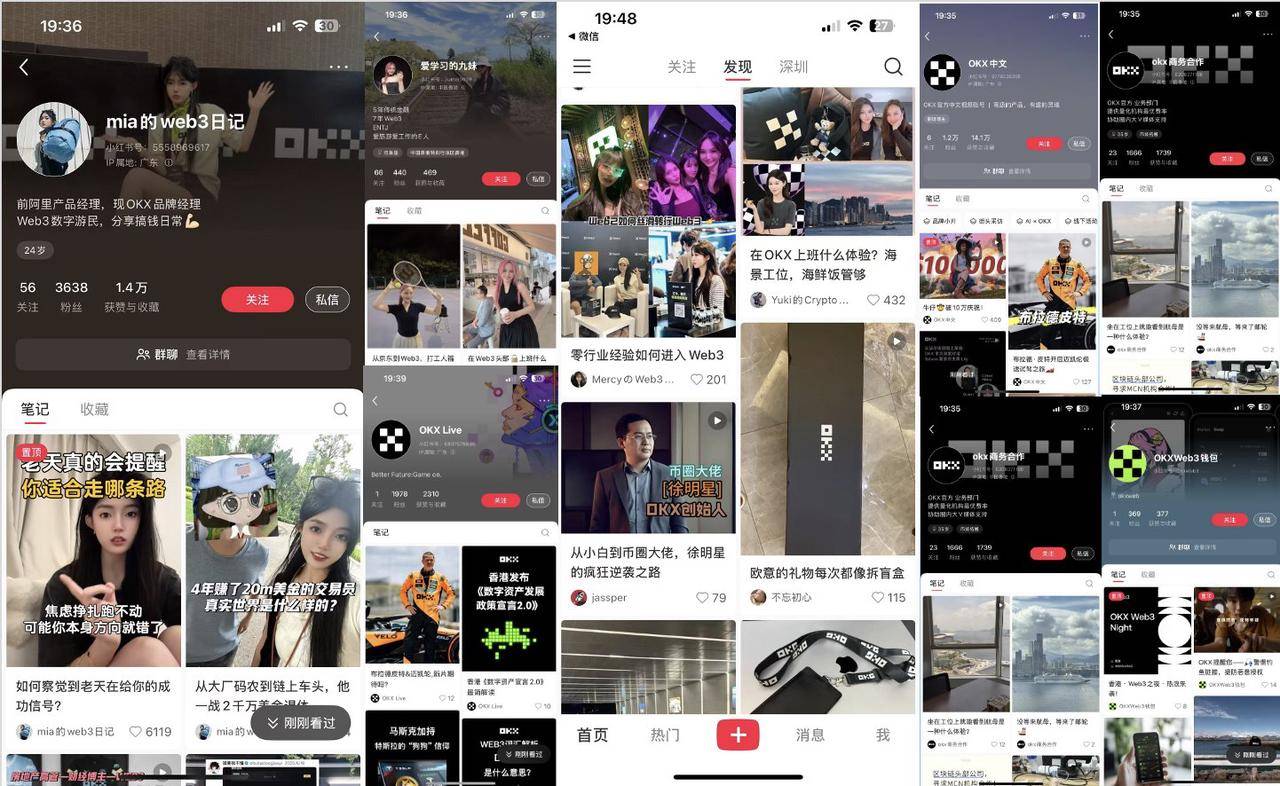Author: Ada, TechFlow
Original Title: Crypto Exchanges Hunting on Xiaohongshu
"I heard Xiaohongshu requires 10,000 followers to apply for Binance campus recruitment?"

A Xiaohongshu screenshot caused a stir in the crypto job-seeking group.
"Even harder than a 985 university degree," someone joked in the comments.
In fact, Binance's official job description does not have a "hard fan threshold" but clearly states: "Priority given to those with successful social media account operation experience, especially in video, Xiaohongshu, and AI-related content directions."
This is no joke. Crypto KOL "AB Kuai.Dong" directly stated on X (Twitter):
"Major exchanges' attitude towards Xiaohongshu has shifted from 'whether to do it' to 'how to do it big', and they are now specifically recruiting fresh graduates with Xiaohongshu account growth experience."
From Weibo, Twitter, and TikTok to now Xiaohongshu, exchanges' marketing battlefields are quietly shifting.
This shift is not a momentary impulse.
Between 2023-2024, Xiaohongshu's user profile underwent a key change: investment, finance, overseas life, and remote work content grew exponentially; users aged 25-35, from first and second-tier cities, with undergraduate degrees or higher accounted for over 60%.
These are precisely the core users crypto exchanges want to compete for.
On this platform that started with beauty and fashion, exchanges are carefully exploring platform boundaries, packaging their "ambitions" with street interview videos, workplace stories, and wealth notes.
Is Xiaohongshu truly a new growth paradise for the crypto industry?
Crypto Traffic Migration History
To understand why exchanges are betting on Xiaohongshu, one must first understand the "crypto traffic migration history".
In many old crypto veterans' memories, Weibo was long the public opinion center of the Chinese crypto world.
Between 2017 and 2022, exchange executives sparred on Weibo, competing for personas and making bold statements, like an industry "public arena". Many newcomers completed their first trade through Weibo crypto bloggers' popularization and shilling.
At that time, whenever Bitcoin surged, an exchange would invest in buying Weibo hot searches, letting terms like "Bitcoin surge" top the list and attract countless retail investors.
However, everything stopped abruptly after regulatory implementation. As policies tightened, Justin Sun, He Yi, and other industry OG accounts were shut down, and many KOLs were thoroughly cleared. Everyone was forced to migrate, ultimately converging on today's X (Twitter), forming a new Chinese crypto social circle.
X (Twitter) is certainly the crypto world's largest "square" - Vitalik publishes Ethereum upgrade progress here, CZ responds to doubts, and various KOLs engage in verbal battles. But the problem precisely lies here: it's too "insider".
After years of traffic competition, potential new crypto users have long been divided by KOLs with invitation links, and today's market looks more like a tug-of-war among existing users.
For most Chinese-speaking users, Twitter always feels like a glass wall, unable to reach the lower-tier market or leverage a broader audience.
TikTok was once seen as a potential "crypto traffic gold mine". It has unparalleled content explosion power, but the problem is: this explosion is hard to solidify.
Fast-food style content consumption struggles to build the trust required for financial products.
"TikTok content's lifecycle is too short," commented new media analyst Youdu Zhi, "Its design intent is exposure and traffic, not trust. Once outside TikTok, its influence quickly diminishes and is hard to settle into users' daily lives."
Bilibili once carried exchanges' educational content, from "crypto coin popularization" to "strategy teaching", serving as a window for new user traffic.
Similar to Weibo's predicament, with increasing regulation, terms like "Bitcoin" and "exchange" were systematically restricted, creators were exhausted, and exchanges' investments gradually lost stability.
Unlike these old battlefields, Xiaohongshu has quietly completed a thorough evolution in the past two years.
It's no longer just a beauty and fashion sharing community. Content about investment, finance, tech exploration, and overseas life has grown exponentially, with users aged 25-35, from first and second-tier cities, with undergraduate degrees or higher accounting for over 60%.
This group is exactly the core customer base crypto exchanges dream of.
More importantly, Xiaohongshu's traffic distribution is completely different from TikTok.
It doesn't rely on top bloggers' monopoly but allows KOCs with just 1000 followers to gain significant exposure. For instance, a regular Xiaohongshu user's post "Bybit still allows card opening, hurry" can receive thousands of likes and interactions.
Xiaohongshu's another secret weapon is its natural "trust chain".
Unlike public traffic platforms, Xiaohongshu's community is human-centered. Users interact with bloggers in comments, consult via private messages, even join group chats, making the entire process feel like friend-to-friend recommendations rather than cold advertisements.
For high-threshold, high-learning-cost crypto products, this chain means a shorter conversion distance.
Xinbang's research report even calls Xiaohongshu the "social e-commerce trust engine":
It integrates internet celebrity traffic, sales information flow, and consumer opinion leader attributes. Traffic depends more on users' active searches than platform recommendations, making sales conversion more precise and less likely to cause annoyance.
So when we see Binance, OKX, Bitget start investing resources in Xiaohongshu, it's not a momentary "trick" but a strategic bet following new traffic logic.
Exchanges' Covert Growth Technique
"OKX cut more than half of its Twitter KOL investment budget and started heavily focusing on Xiaohongshu. Many internal departments are simultaneously working on Xiaohongshu, with the Chinese language department almost entirely dedicated to it."
Crypto blogger Wuwei exposed on X.
On Xiaohongshu, OKX's "North Electric Campus Beauty" themed street interview video received over 87,000 likes. Similar themed interviews almost always easily break 10,000 likes, and Nezha series AI shorts also get thousands of collections.
OKX clearly does more than just make videos. Its Xiaohongshu strategy looks more like a carefully planned marketing layout: official accounts create topics, employee accounts infiltrate various content circles, a matrix-like penetration.
Besides the official account, employees like Jiumei, Mercy, and Mia have accumulated many followers with "Web3 career transition experiences" and "Exchange workplace daily life" narratives. They seem independent but frequently interact with official accounts in comments, creating secondary exposure and closing the distance.

This matrix approach can offset account ban risks while allowing the brand to penetrate more细分 user pools, such as young professionals wanting to enter Web3 or freelancers pursuing a "digital nomad" lifestyle.
For exchanges, Xiaohongshu's role might not just be acquiring direct registered users. More often, it plays a "brand display window" role - penetrating content to make potential users familiar with and recognize the exchange brand, so they think of it first when they truly need trading.
Real efficient conversion often happens in the "underground world".
Multiple civilian studios have long been active on Xiaohongshu, tirelessly placing conversion notes.
These notes typically disguise themselves as "Pit Avoidance Guides," "Financial Diaries," or "Beginner Tutorials" to attract users to join groups or private chats, then throw out registration links. Once users deposit and start trading, these promoters can receive commission income long-term, and some studios even directly place registration ads on Xiaohongshu - which is one of the most stable gray businesses in the crypto.

On Xiaohongshu, cryptocurrencies are often not just cold financial tools, but packaged as a lifestyle choice.
Instead of saying "investing in cryptocurrencies," they say 'How I achieve over 10,000 in passive monthly income'; instead of discussing K-line charts, they share financial insights of digital nomads; instead of technical analysis, they talk about wealth freedom paths for post-00s generation...
This "lifestyle" packaging perfectly matches Xiaohongshu's content ecosystem and lowers users' psychological barriers.
Crypto blogger Viki summarized the currently valuable Web3 account types on Xiaohongshu:
Career consulting: Sharing career transition experiences, attracting job seekers;
Investment insights: Seemingly life records, actually investment tutorials;
Lifestyle: Stories of digital nomads, remote work, overseas living;
Personal IP: Establishing trust through strong identity labels.
"Exchanges will collaborate with KOLs or KOCs having these four account types, ultimately guiding users into communities and completing conversions through registration referral links," Viki explained.
Behind this, exchanges are attempting a long-term brand transformation: from cold trading tools to community companions, and even "narrative leaders".
Dancing on Thin Ice
Crypto exchanges flooding into Xiaohongshu seems like the first step to escape "crypto jargon" and enter mainstream social context, but this path is not smooth.
The trader "Crypto Poison" with 50,000 Twitter followers directly stated that doing Xiaohongshu is an "extremely low-value proposition". He had to pay the price of over 20 accounts being repeatedly banned before understanding the rules.
"Back then, the industry hadn't been competitive, but now with exchanges madly entering, traffic is no longer a blue ocean," another KOL "Digital Trend" said, describing current Xiaohongshu as "internal competition within a siege", with bonus periods already disappeared.
Besides fierce competition, the platform's review mechanism is another high wall.
"Low traffic means no effect, high traffic triggers manual review," Viki summarized, "Once repeatedly violating rules, you'll be lightly restricted in traffic or severely banned - creating content is like dancing in shackles."
To avoid pitfalls, many creators must design unique strategies for different stages, from copywriting to layout and traffic diversion, further lowering input-output ratio.
More tricky are compliance and user cognitive risks. Xiaohongshu's mainstream user group is mostly young people who lack understanding of contracts, leverage, and on-chain assets. A slight mistake might cause financial losses due to misleading information, potentially triggering stricter regulation. Even though the platform currently maintains some ambiguous space for crypto content, with financial content management becoming standardized, any public opinion explosion could lead to a complete ban.
Risks are obvious, but exchanges are still investing heavily.
"If you don't rush in, competitors will get ahead," a crypto exchange marketing manager said.
This is exactly like a classic "prisoner's dilemma":
If only you do it, you can indeed grab the bonus
If everyone does it, bonuses get diluted and risks amplified
If you don't do it, you'll watch competitors harvest users
So even knowing there are traffic traps and potential risks, they still jump in.
Breaking boundaries always comes at a cost - the question is whether this cost is worth it?
Exchanges' adventures on Xiaohongshu are like dancing on thin ice - every step could be the last, but when the music plays, no one wants to stop.
How long will this traffic carnival last? Nobody knows the answer.
The only certainty is: in an era of increasingly expensive traffic and stricter regulation, the "easy money" period has gone forever. What exchanges need to consider is not just how to acquire users, but how to truly create value under compliance and sustainability premises.
Otherwise, today's Xiaohongshu might become tomorrow's Weibo.
History doesn't repeat, but always rhymes.
Twitter:https://twitter.com/BitpushNewsCN
Bitpush TG Group:https://t.me/BitPushCommunity
Bitpush TG Channel: https://t.me/bitpush






